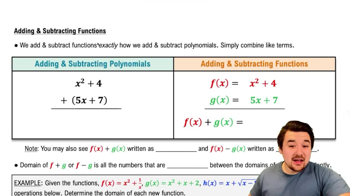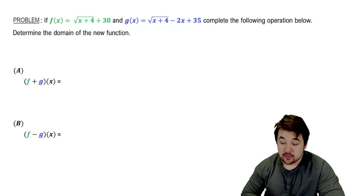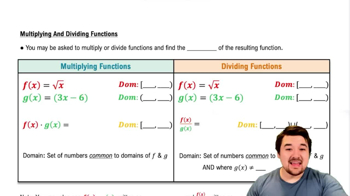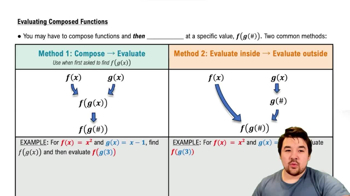Table of contents
- 0. Functions7h 52m
- Introduction to Functions16m
- Piecewise Functions10m
- Properties of Functions9m
- Common Functions1h 8m
- Transformations5m
- Combining Functions27m
- Exponent rules32m
- Exponential Functions28m
- Logarithmic Functions24m
- Properties of Logarithms34m
- Exponential & Logarithmic Equations35m
- Introduction to Trigonometric Functions38m
- Graphs of Trigonometric Functions44m
- Trigonometric Identities47m
- Inverse Trigonometric Functions48m
- 1. Limits and Continuity2h 2m
- 2. Intro to Derivatives1h 33m
- 3. Techniques of Differentiation3h 18m
- 4. Applications of Derivatives2h 38m
- 5. Graphical Applications of Derivatives6h 2m
- 6. Derivatives of Inverse, Exponential, & Logarithmic Functions2h 37m
- 7. Antiderivatives & Indefinite Integrals1h 26m
0. Functions
Combining Functions
Problem 60
Textbook Question
Missing piece Let g(x) = x² + 3 Find a function ƒ that produces the given composition.
(g o ƒ ) (x) = x²⸍³ + 3
 Verified step by step guidance
Verified step by step guidance1
Step 1: Understand the composition (g \circ f)(x) = g(f(x)). We need to find a function f(x) such that when g is applied to f(x), it results in x^{2/3} + 3.
Step 2: Recall that g(x) = x^2 + 3. We want g(f(x)) = f(x)^2 + 3 to equal x^{2/3} + 3.
Step 3: Set up the equation f(x)^2 + 3 = x^{2/3} + 3.
Step 4: Subtract 3 from both sides to isolate the squared term: f(x)^2 = x^{2/3}.
Step 5: Solve for f(x) by taking the square root of both sides: f(x) = \sqrt{x^{2/3}}.
Was this helpful?

 5:56m
5:56mWatch next
Master Adding & Subtracting Functions with a bite sized video explanation from Nick
Start learning




